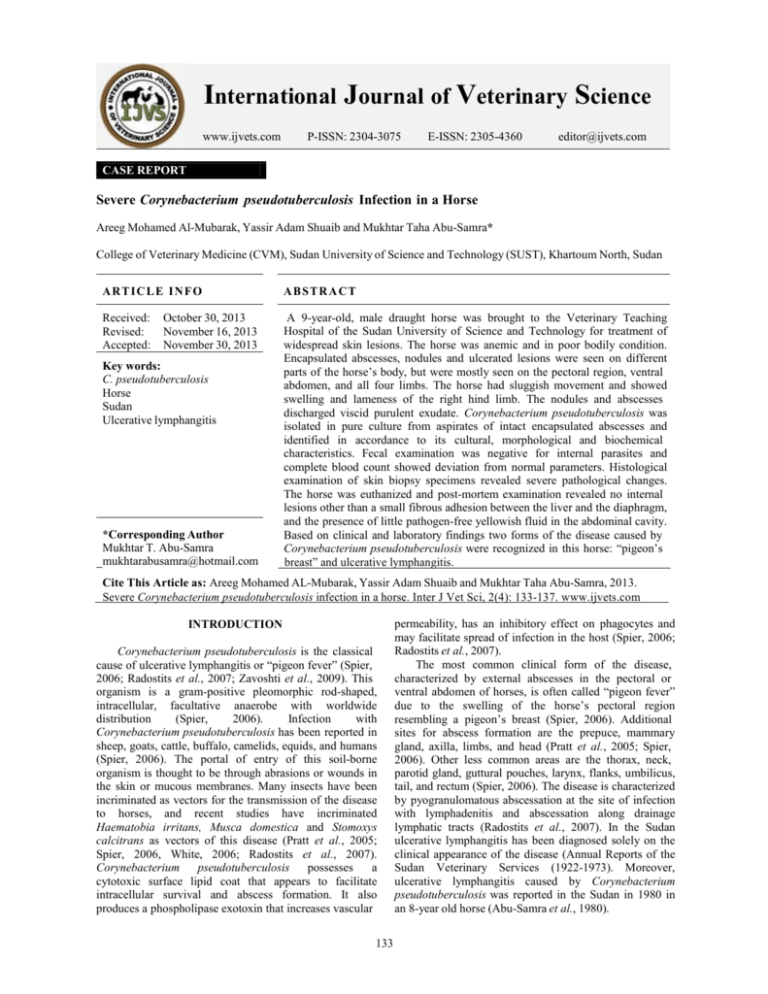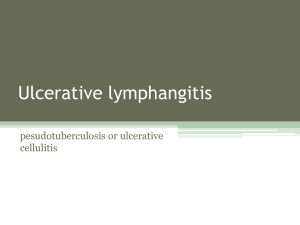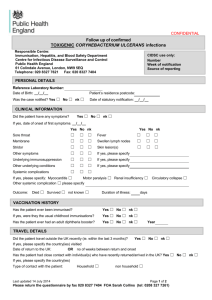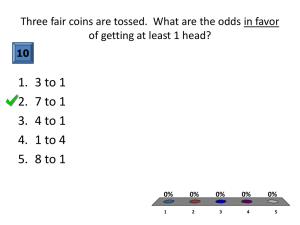Microsoft Word - 13-56 composed_finalized
advertisement

International Journal of Veterinary Science www.ijvets.com P-ISSN: 2304-3075 E-ISSN: 2305-4360 editor@ijvets.com CASE REPORT Severe Corynebacterium pseudotuberculosis Infection in a Horse Areeg Mohamed Al-Mubarak, Yassir Adam Shuaib and Mukhtar Taha Abu-Samra* College of Veterinary Medicine (CVM), Sudan University of Science and Technology (SUST), Khartoum North, Sudan A R T I C L E I N FO Received: Revised: Accepted: October 30, 2013 November 16, 2013 November 30, 2013 Key words: C. pseudotuberculosis Horse Sudan Ulcerative lymphangitis *Corresponding Author Mukhtar T. Abu-Samra mukhtarabusamra@hotmail.com ABSTRACT A 9-year-old, male draught horse was brought to the Veterinary Teaching Hospital of the Sudan University of Science and Technology for treatment of widespread skin lesions. The horse was anemic and in poor bodily condition. Encapsulated abscesses, nodules and ulcerated lesions were seen on different parts of the horse’s body, but were mostly seen on the pectoral region, ventral abdomen, and all four limbs. The horse had sluggish movement and showed swelling and lameness of the right hind limb. The nodules and abscesses discharged viscid purulent exudate. Corynebacterium pseudotuberculosis was isolated in pure culture from aspirates of intact encapsulated abscesses and identified in accordance to its cultural, morphological and biochemical characteristics. Fecal examination was negative for internal parasites and complete blood count showed deviation from normal parameters. Histological examination of skin biopsy specimens revealed severe pathological changes. The horse was euthanized and post-mortem examination revealed no internal lesions other than a small fibrous adhesion between the liver and the diaphragm, and the presence of little pathogen-free yellowish fluid in the abdominal cavity. Based on clinical and laboratory findings two forms of the disease caused by Corynebacterium pseudotuberculosis were recognized in this horse: “pigeon’s breast” and ulcerative lymphangitis. Cite This Article as: Areeg Mohamed AL-Mubarak, Yassir Adam Shuaib and Mukhtar Taha Abu-Samra, 2013. Severe Corynebacterium pseudotuberculosis infection in a horse. Inter J Vet Sci, 2(4): 133-137. www.ijvets.com INTRODUCTION Corynebacterium pseudotuberculosis is the classical cause of ulcerative lymphangitis or “pigeon fever” (Spier, 2006; Radostits et al., 2007; Zavoshti et al., 2009). This organism is a gram-positive pleomorphic rod-shaped, intracellular, facultative anaerobe with worldwide distribution (Spier, 2006). Infection with Corynebacterium pseudotuberculosis has been reported in sheep, goats, cattle, buffalo, camelids, equids, and humans (Spier, 2006). The portal of entry of this soil-borne organism is thought to be through abrasions or wounds in the skin or mucous membranes. Many insects have been incriminated as vectors for the transmission of the disease to horses, and recent studies have incriminated Haematobia irritans, Musca domestica and Stomoxys calcitrans as vectors of this disease (Pratt et al., 2005; Spier, 2006, White, 2006; Radostits et al., 2007). Corynebacterium pseudotuberculosis possesses a cytotoxic surface lipid coat that appears to facilitate intracellular survival and abscess formation. It also produces a phospholipase exotoxin that increases vascular 133 permeability, has an inhibitory effect on phagocytes and may facilitate spread of infection in the host (Spier, 2006; Radostits et al., 2007). The most common clinical form of the disease, characterized by external abscesses in the pectoral or ventral abdomen of horses, is often called “pigeon fever” due to the swelling of the horse’s pectoral region resembling a pigeon’s breast (Spier, 2006). Additional sites for abscess formation are the prepuce, mammary gland, axilla, limbs, and head (Pratt et al., 2005; Spier, 2006). Other less common areas are the thorax, neck, parotid gland, guttural pouches, larynx, flanks, umbilicus, tail, and rectum (Spier, 2006). The disease is characterized by pyogranulomatous abscessation at the site of infection with lymphadenitis and abscessation along drainage lymphatic tracts (Radostits et al., 2007). In the Sudan ulcerative lymphangitis has been diagnosed solely on the clinical appearance of the disease (Annual Reports of the Sudan Veterinary Services (1922-1973). Moreover, ulcerative lymphangitis caused by Corynebacterium pseudotuberculosis was reported in the Sudan in 1980 in an 8-year old horse (Abu-Samra et al., 1980). 134 Inter J Vet Sci, 2013, 2(4): 133-137. MATERIALS AND METHODS Clinical and Laboratory Investigations A 9-year-old male draught horse was brought to the Veterinary Teaching Hospital (VTH) of the College of Veterinary Medicine (CVM), Sudan University of Science and Technology (SUST) in July/2012. The main complaint according to the owner was severe and extensive skin lesions involving the whole body. Four months before submission for examination; the owner observed solitary nodules involving the lateral and medial aspects of the fore and hind quarters, neck, chest and abdomen. After carrying out a thorough clinical examination, blood was collected from the jugular vein, complete blood count (CBC) was conducted; the values obtained were expressed in the systeme international d’unites (SI) and compared with the range of values documented by Blood and Studdert (1999). Fecal specimens were examined for internal parasites. Impression smears were prepared from abscesses and stained with Gram’s stain. Aspirates of pus were aseptically collected from intact encapsulated abscesses, and abdominal fluid was aseptically collected during post-mortem examination were subjected to bacteriological examination and culture in accordance to Barrow and Feltham (2003). Biopsy and necropsy specimens were fixed in 10 per cent formal saline, processed, embedded in wax, cut at 5-6 µm and stained with haematoxylin and eosin stain for histological examination. Fig. 1: Corynebacterium pseudotuberculosis on the pectoral muscles of a horse showing typical “pigeon breast” form of the disease. Fig. 2: Abscesses draining on the ventrum of a horse-caused by Corynebacterium pseudotuberculosis. RESULTS The horse was in poor bodily condition. Encapsulated abscesses, crust covered and ulcerated lesions were seen on different parts of the horse’s body, but are mostly seen on the pectoral region (Fig. 1), ventral abdomen (Fig. 2), and all four limbs extending from elbows down to hooves (Fig. 3) and from thighs down to hooves (Fig. 4). Abscesses and ulcers were also seen on the head concentrating round the mouth commissure (Fig.3) the axilla (Fig. 5) and prepuce (Fig. 6), and solitary lesions were also encountered on the neck (Fig. 7), thorax, flanks and rectum. Enlarged draining lymphatics with many encapsulated abscesses developing along them; were seen on the thorax extending between the elbow joint and sternum (Fig. 8). The nodules and abscesses discharge viscid purulent exudate. The horse had poor appetite, had sluggish movement and was dragging its right hind limb with local rise in temperature. Palpation of the skin was extremely resented by the animal. On physical examination the horse had tachycardia (57/min) and tachypnea (32/min.), the rectal temperature was 37.9 °C and the mucous membranes were faint pink in color. Fecal examination was negative for internal parasites. The complete blood count (CBC) picture was as follows: Haemoglobin Concentration (Hb) of 83 (g/l), Packed Cell Volume (PCV) was 0.30 (l/l), Total Red Blood Cell Count (TRBC) was 6.81 (x 1012/l), Total White Blood Cell Count (TWBC) was 2 (x109/l), While the Differential Cell Count was: 1.22 (x9/l) Neutrophils, 0.62 (x9/l) lymphocytes, 0.14 (x109/l) Eosinophils, 0.02 (x9/l) Monocytes and 0 Basophils. The results obtained showed Fig. 3: Lesions of ulcerative lymphangitis in a horse, showing typical pattern of invasion of the lymphatic vessels affecting the entire forelimbs from elbows to hooves and head. Note: concentration of lesions round the mouth commissare Fig. 4: Lesions of ulcerative lymphangitis in a horse, showing typical pattern of invasion of the lymphatic vessels affecting the entire hindlimbs from thighs to hooves. Note: swelling of the right hindlimb. 135 Fig. 5: Abscesses and ulcers caused by Corynebacterium pseudotuberculosis involving the axilla in a horse. Fig. 6: Abscesses and ulcers caused by Corynebacterium pseudotuberculosis involving the prepuce and thigh region of a horse. Inter J Vet Sci, 2013, 2(4): 133-137. that the horse was anemic and had marked reduction in the total WBC. Impression smears from abscesses revealed Gram positive pleomorphic rods with typical Chinese letters arrangements. Corynebacterium pseudotuberculosis was isolated in pure culture from aspirates of intact encapsulated abscesses, and identified in accordance to authentic methods and techniques. Nonmotile, Gram positive pleomorphic rods with typical Chinese letters arrangements were seen in smears prepared from pure culture. The organism was also positive for metachromatic (volutin) granules using modified Albert’s stain. It was catalase and urease positive, reduced nitrate and produced acid from glucose, maltose and sucrose. Post-mortem examination revealed no internal lesions other than a small fibrous adhesion between the liver and the diaphragm, and the presence of little pathogen-free yellowish fluid in the abdominal cavity. Histological examination of skin biopsy specimens revealed epidermal degeneration, necrosis and scab formation. The dermis showed severe damage to collagen and adnexal structures and hemorrhage. There was abscess formation involving the subcutaneous tissue and the overlying skin. Central zones of necrosis and pus were surrounded by macrophages, neutrophils and proliferated fibrous tissue. Based on laboratory findings confirming our tentative diagnosis; two forms of the disease caused by Corynebacterium pseudotuberculosis were seen in this horse: The first form was characterized by numerous draining abscesses mainly on the pectoral region “pigeon’s breast” and ventral abdomen, and the second form was ulcerative lymphangitis involving the four limbs and was characterized by limb swelling, cellulitis and numerous draining tracts along the lymphatics showing nodular and ulcerative lesions. DISCUSSION Fig. 7: Abscesses and ulcers caused by Corynebacterium pseudotuberculosis involving the neck of a horse. Fig. 8: Encapsulated abscesses developing along an enlarged lymphatic vessel in a horse infected with Corynebacterium pseudotuberculosis. Our tentative diagnosis based on the clinical picture of the typical lesions was confirmed by the isolation of the causative agent of these lesions in pure culture from pus aspirates of encapsulated abscesses. These findings authenticated the findings of Aleman and Spier (2002), Spier (2006) and Zavoshti et al. (2009) who reported that Corynebacterium pseudotuberculosis is the classical cause of ulcerative lymphangitis or “pigeon’s breast”. In a previous investigation in the Sudan only one form of this disease was reported in an 8-year old horse (Abu-Samra et al., 1980). While in the current investigation many external abscesses were seen on the right lateral side of the head extending from mandible curvature to lips, concentrating round the mouth commissure and a few lesions were also seen on the left lateral side of the head. Many external abscesses were noticed on the axilla. Solitary lesions were also encountered on the neck, thorax, flanks and prepuce. These observations supported the findings of Pratt et al. (2005) and Spier (2006) who reported that additional sites for abscess formation are the prepuce, mammary gland, axilla, limbs and head, and other less common areas are the thorax, neck, parotid gland, guttural pouches, larynx, flank, umbilicus, tail and rectum. Our observation of enlarged draining lymphatics on the thorax with many nodules developing along them 136 was in line with what have been stated out by Radostits et al. (2007) who reported that lymphatics draining the area become enlarged and hard and secondary ulcers may develop along them. Infection caused by Corynebacterium pseudotuberculosis is characterized by deep intramuscular abscesses in the pectoral and ventral abdomen of horses, infection of limb lymphatics or internal organs, including the liver, kidneys or spleen (Aleman and Spier, 2002; Spier, 2006; Gorman et al., 2010). However, in the current investigation only the first two forms of the disease were observed, and despite the fact that the horse showed tachycardia (57/min) and tachypnea (32/min); no lesions were observed in internal organs except for a small adhesion between the liver and diaphragm. Moreover, culture of the abdominal fluid was negative for Corynebacterium pseudotuberculosis or other pathogenic organisms. The deviation of these physical parameters from the normal range was mainly, if not solely attributed to the poor condition of the animal, anaemia and the deleterious effect of the toxins produced by the organism. In support to these findings, Spier (2006) reported that horses with external abscesses do not usually develop signs of systemic illness. In the current investigation ulcerative lymphagitis lesions were seen involving the four limbs of the horse from elbows and hocks joints to hooves. The horse is a 9year old draught animal, prone to abrasions and injuries especially on the pastern joints. These abrasions and injuries might have facilitated the entry of the soil borne Corynebacterium pseudotuberculosis causing infection of lymphatic vessels and spread on all parts of the body. The virulence of the organism is boosted by the various extracellular exotoxins produced by the organism causing vascular damage and inhibits phagocytes, facilitating spread of infection and exacerbating the disease as was clearly evident from the clinical and CBC picture observed in the current investigation. These findings did confirm the findings of previous workers like Pratt et al. (2005), Spier (2006), White (2006) and Radostits et al. (2007) who reported that the portal of entry of the soilborne Corynebacterium pseudotuberculosis is thought to be through abrasions or wounds in the skin or mucous membranes, but Valentine and Mcgavin (2007) reported that the organism can enter the muscle by penetrating open wounds. Our findings also supported the findings of Spier (2006), Radostits et al. (2007) and Mamman et al. (2011) who reported that the organism possesses a cytotoxic surface lipid coat that appears to facilitate intracellular survival and abscess formation. It also produces a phospholipase exotoxin that increases vascular permeability, has an inhibitory effect on phagocytes and may facilitate spread of infection in the host. The horse was euthanized after the consent of the owner, for humane reasons because the animal was in poor bodily condition, anemic, with severe lesions involving extensive areas of the body, and manifesting pain and inhibition of phagocytic responses, resulting from the toxins produced by the bacteria. The second reason for sacrificing the horse is for prevention of spread of the disease to other animals in the area by Musca domestica and Stomoxys calcitrans flies that were seen in large numbers feeding on the lesions. This finding is in Inter J Vet Sci, 2013, 2(4): 133-137. agreement with many other workers Pratt et al. (2005), Spier (2006), White (2006) and Radostits et al. (2007) who incriminated Haematobia irritans, Musca domestica and Stomoxys calcitrans as vectors for the transmission of the disease to horses. The third reason for sacrificing the animal is our anticipation that treatment might not be successful in producing complete recovery because of the intracellular location of the organism and presence of exudates. In addition to this, the duration of therapy may be long and the cost of the drugs used might be prohibitively expensive for the owner. Moreover, Orsini et al. (2010) reported that an antibiotic could be effective in vitro that might not be effective for the organism in vivo; Spier (2006) reported that several factors should be considered when choosing an antimicrobial: the intracellular location of the organism, the presence of exudates and a thick abscess capsule and the duration of therapy are important as the cost of the drug and the convenience of administration, and Mamman et al. (2011) reported that various protocols are being used in the management of ulcerative lymphangitis but the disease seems to always recur in an animal that has once had the clinical disease. REFERENCES Abu-Samra MT, SE Imbabi, KA Mohamed and EA Karib, 1980. Ulcerative lymphangitis in a horse. Equine Vet J, 12: 149-150. Aleman MR and SJ Spier, 2002. Corynebacterium pseudotuberculosis Infection. In: Smith BP, 3rd ed, Large Animal Internal Medicine. St Louis, CV Mosby Co, 1078-1084. Annual Reports of the Sudan Veterinary Services (19221973). Barrow GI and RKA Feltham, 2003. Cowan and Steels Manual for the identification of medical bacteria (3rd ed). Cambridge University Press, Cambridge, UK. Blood DC and VP Studdert, 1999. Saunders Comprehensive Veterinary Dictionary. WB Saunders, 2nd ed, Hematological reference values: SI units, pp: 1252. Gorman JK, M Gabriel, NJ Maclachlan, NC Nieto, JE Foley and SJ Spier, 2010. Pilot immunization of mice infected with an equine strain of Corynebacterium pseudotuberculosis. Vet Therapeutics, 11: E1-E8. Mamman PH, WP Mshelia and IE Fadimu, 2011. Antimicrobial susceptibility of aerobic bacteria and fungi isolated from cases of equine ulcerative lymphangitis in Kano Metropolis, Nigeria. Asian J Anim Sci, 5: 175-182. Orsini JA, Y Elce and B Kraus, 2005. Management of several infected wounds in the equine patient. Clinical Technical Equine Practice, 3: 225-236. Pratt SM, SJ Spier, SP Carroll, P Vaughan, MB Whitcomb and WD Wilson, 2005. Evaluation of clinical characteristics, diagnostic test results, and outcome in horses with internal infection caused by Corynebacterium pseudotuberculosis: 30 cases (1995-2003). J Amer Vet Med Assoc, 227: 441-448. Radostits OM, CC Gay, KW Hinchcliff and PD Constable, 2007. Veterinary Medicine, A textbook of the diseases of cattle, horses, sheep, pigs and goats. 10th edition Saunders Co, Philadelphia; 798-800. 137 Spier SJ, 2006. Dryland Distemper- Corynebacterium pseudotuberculosis infections in horses. California Vet, 38: 24-26. Valentine BA and MD Mcgavin, 2007. Skeletal Muscle. In: Pathologic Basis of Veterinary Diseases, McGavin MD and JF Zachary (Eds). Mosby Publisher Inc, StLouis, Missmni, pp: 1010. Inter J Vet Sci, 2013, 2(4): 133-137. White SD, 2006. In-depth: Selected Topics in Dermatology, Nodules-Infectious. Proceedings of the American Association of Equine Practitioners, 52: 476-477. Zavoshti FR, AB Sioofy-khojine and HA Mahpeikar, 2009. A case report of ulcerative lymphangitis (A mini review of causes and current therapies). Turk J Vet Anim Sci, 33: 525-528.







